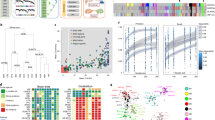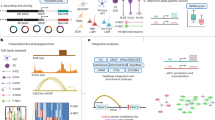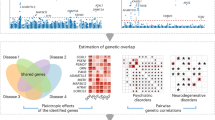Abstract
Neurological and psychiatric disorders have overlapped phenotypic profiles, but the underlying tissue-specific functional processes remain largely unknown. In this study, we explore the shared tissue-specificity among 14 neuropsychiatric disorders through the disrupted long-range gene regulations by GWAS-identified regulatory SNPs. Through Hi-C interactions, averagely 38.0% and 17.2% of the intergenic regulatory SNPs can be linked to target protein-coding genes in brain and non-brain tissues, respectively. Interestingly, while the regulatory target genes in the brain tend to enrich in nervous system development related processes, those in the non-brain tissues are inclined to interfere with synapse and neuroinflammation related processes. Compared to psychiatric disorders, neurological disorders present more prominently the neuroinflammatory processes in both brain and non-brain tissues, indicating an intrinsic difference in mechanisms. Through tissue-specific gene regulatory networks, we then constructed disorder similarity networks in two brain and three non-brain tissues, highlighting both known disorder clusters (e.g. the neurodevelopmental disorders) and unexpected disorder clusters (e.g. Parkinson’s disease is consistently grouped with psychiatric disorders). We showcase the potential pharmaceutical applications of the small bowel and its disorder clusters, illustrated by the known drug targets NR1I3 and NFACT1, and their small bowel-specific regulatory modules. In conclusion, disrupted long-range gene regulations in both brain and non-brain tissues contribute to the similarity among distinct clusters of neuropsychiatric disorders, and the tissue-specifically shared functions and regulators for disease clusters may provide insights for future therapeutic investigations.
This is a preview of subscription content, access via your institution
Access options
Subscribe to this journal
Receive 12 print issues and online access
$259.00 per year
only $21.58 per issue
Buy this article
- Purchase on SpringerLink
- Instant access to full article PDF
Prices may be subject to local taxes which are calculated during checkout



Similar content being viewed by others
Data availability
The original public datasets were downloaded as described in “Materials and Methods”. The processed datasets supporting the conclusions of this article are included within the article and its supplementary files (supplementary information is available at MP’s website). All codes for the analyses are available upon request, and essential codes are available at https://github.com/JChen-GitHub/daSNP_interpretation_np.
Code availability
The codes are publicly available at https://github.com/JChen-GitHub/daSNP_interpretation_np.
References
Group GBDNDC. Global, regional, and national burden of neurological disorders during 1990-2015: a systematic analysis for the Global Burden of Disease Study 2015. Lancet Neurol. 2017;16:877–97.
Sullivan PF, Geschwind DH. Defining the genetic, genomic, cellular, and diagnostic architectures of psychiatric disorders. Cell. 2019;177:162–83.
Buniello A, MacArthur JAL, Cerezo M, Harris LW, Hayhurst J, Malangone C, et al. The NHGRI-EBI GWAS Catalog of published genome-wide association studies, targeted arrays and summary statistics 2019. Nucleic Acids Res. 2019;47:D1005–D12. D1.
Sullivan PF. The psychiatric GWAS consortium: big science comes to psychiatry. Neuron. 2010;68:182–6.
Cross-Disorder Group of the Psychiatric Genomics C. Identification of risk loci with shared effects on five major psychiatric disorders: a genome-wide analysis. Lancet. 2013;381:1371–9.
Cross-Disorder Group of the Psychiatric Genomics Consortium. Electronic address pmhe, Cross-Disorder Group of the Psychiatric Genomics C. Genomic Relationships, Novel Loci, and Pleiotropic Mechanisms across Eight Psychiatric Disorders. Cell. 2019;179:1469–82 e11.
Maurano MT, Humbert R, Rynes E, Thurman RE, Haugen E, Wang H, et al. Systematic localization of common disease-associated variation in regulatory DNA. Science. 2012;337:1190–5.
Xiao X, Chang H, Li M. Molecular mechanisms underlying noncoding risk variations in psychiatric genetic studies. Mol Psychiatry. 2017;22:497–511.
Chen J, Tian W. Explaining the disease phenotype of intergenic SNP through predicted long range regulation. Nucleic Acids Res. 2016;44:8641–54.
Wang D, Liu S, Warrell J, Won H, Shi X, Navarro FCP, et al. Comprehensive functional genomic resource and integrative model for the human brain. Science. 2018;362:6420.
Song M, Yang X, Ren X, Maliskova L, Li B, Jones IR, et al. Mapping cis-regulatory chromatin contacts in neural cells links neuropsychiatric disorder risk variants to target genes. Nat Genet. 2019;51:1252–62.
Gamazon ER, Zwinderman AH, Cox NJ, Denys D, Derks EM. Multi-tissue transcriptome analyses identify genetic mechanisms underlying neuropsychiatric traits. Nat Genet. 2019;51:933–40.
Liu P, Wu L, Peng G, Han Y, Tang R, Ge J, et al. Altered microbiomes distinguish Alzheimer’s disease from amnestic mild cognitive impairment and health in a Chinese cohort. Brain Behav Immun. 2019;80:633–43.
Shen Y, Xu J, Li Z, Huang Y, Yuan Y, Wang J, et al. Analysis of gut microbiota diversity and auxiliary diagnosis as a biomarker in patients with schizophrenia: A cross-sectional study. Schizophr Res. 2018;197:470–7.
Sey NYA, Hu B, Mah W, Fauni H, McAfee JC, Rajarajan P, et al. A computational tool (H-MAGMA) for improved prediction of brain-disorder risk genes by incorporating brain chromatin interaction profiles. Nat Neurosci. 2020;23:583–93.
de Leeuw CA, Mooij JM, Heskes T, Posthuma D. MAGMA: generalized gene-set analysis of GWAS data. PLoS Comput Biol. 2015;11:e1004219.
Yu G, Li F, Qin Y, Bo X, Wu Y, Wang S. GOSemSim: an R package for measuring semantic similarity among GO terms and gene products. Bioinformatics 2010;26:976–8.
Yang A, Chen J, Zhao XM. nMAGMA: a network-enhanced method for inferring risk genes from GWAS summary statistics and its application to schizophrenia. Brief Bioinform. 2020;22:bbaa298.
Barbeira AN, Dickinson SP, Bonazzola R, Zheng J, Wheeler HE, Torres JM, et al. Exploring the phenotypic consequences of tissue specific gene expression variation inferred from GWAS summary statistics. Nat Commun. 2018;9:1825.
Sullivan PF, Posthuma D. Biological pathways and networks implicated in psychiatric disorders. Curr Opin Behav Sci. 2015;2:58–68.
Skaper SD, Facci L, Zusso M, Giusti P. An Inflammation-Centric View of Neurological Disease: Beyond the Neuron. Front Cell Neurosci. 2018;12:72.
Taber KH, Salpekar J, Wong AH, Hurley RA. Developmental origins for neuropsychiatric illness. J Neuropsychiatry Clin Neurosci. 2011;23:1–5.
Morand-Beaulieu S, Leclerc JB, Valois P, Lavoie ME, O’Connor KP, Gauthier B. A Review of the neuropsychological dimensions of Tourette syndrome. Brain Sci. 2017;7:106.
Calabresi P, Mercuri NB, Di, Filippo M. Synaptic plasticity, dopamine and Parkinson’s disease: one step ahead. Brain 2009;132:285–7. Pt 2
Chaudhari N, Pereira E, Roper SD. Taste receptors for umami: the case for multiple receptors. Am J Clin Nutr. 2009;90:738S–42S.
Spampinato SF, Copani A, Nicoletti F, Sortino MA, Caraci F. Metabotropic Glutamate Receptors in Glial Cells: A New Potential Target for Neuroprotection? Front Mol Neurosci. 2018;11:414.
Vinson PN, Conn PJ. Metabotropic glutamate receptors as therapeutic targets for schizophrenia. Neuropharmacology 2012;62:1461–72.
Langfelder P, Horvath S. WGCNA: an R package for weighted correlation network analysis. BMC Bioinforma. 2008;9:559.
Forsaa EB, Larsen JP, Wentzel-Larsen T, Goetz CG, Stebbins GT, Aarsland D, et al. A 12-year population-based study of psychosis in Parkinson disease. Arch Neurol. 2010;67:996–1001.
Birtwistle J, Baldwin D. Role of dopamine in schizophrenia and Parkinson’s disease. Br J Nurs. 1998;7:832–4. 6, 8-41.
Kuusimaki T, Al-Abdulrasul H, Kurki S, Hietala J, Hartikainen S, Koponen M, et al. Increased risk of parkinson’s disease in patients with Schizophrenia spectrum disorders. Mov Disord. 2021;36:1353–61.
Schrag A, Barone P, Brown RG, Leentjens AF, McDonald WM, Starkstein S, et al. Depression rating scales in Parkinson’s disease: critique and recommendations. Mov Disord. 2007;22:1077–92.
von Bernhardi R. Glial cell dysregulation: a new perspective on Alzheimer disease. Neurotox Res. 2007;12:215–32.
Duffy SS, Lees JG, Moalem-Taylor G. The contribution of immune and glial cell types in experimental autoimmune encephalomyelitis and multiple sclerosis. Mult Scler Int. 2014;2014:285245.
Yang L, Neale BM, Liu L, Lee SH, Wray NR, Ji N, et al. Polygenic transmission and complex neuro developmental network for attention deficit hyperactivity disorder: genome-wide association study of both common and rare variants. Am J Med Genet B Neuropsychiatr Genet. 2013;162B:419–30.
Hawi Z, Cummins TD, Tong J, Johnson B, Lau R, Samarrai W, et al. The molecular genetic architecture of attention deficit hyperactivity disorder. Mol Psychiatry. 2015;20:289–97.
Petra AI, Panagiotidou S, Hatziagelaki E, Stewart JM, Conti P, Theoharides TC. Gut-microbiota-brain axis and its effect on neuropsychiatric disorders with suspected immune dysregulation. Clin Ther. 2015;37:984–95.
Pennisi E. Meet the psychobiome. Science 2020;368:570–3.
Valles-Colomer M, Falony G, Darzi Y, Tigchelaar EF, Wang J, Tito RY, et al. The neuroactive potential of the human gut microbiota in quality of life and depression. Nat Microbiol. 2019;4:623–32.
Olson CA, Vuong HE, Yano JM, Liang QY, Nusbaum DJ, Hsiao EY. The gut microbiota mediates the anti-seizure effects of the ketogenic diet. Cell 2018;174:497.
Pearl JR, Colantuoni C, Bergey DE, Funk CC, Shannon P, Basu B, et al. Genome-scale transcriptional regulatory network models of psychiatric and neurodegenerative disorders. Cell Syst. 2019;8:122–35 e7.
Wishart DS, Feunang YD, Guo AC, Lo EJ, Marcu A, Grant JR, et al. DrugBank 5.0: a major update to the DrugBank database for 2018. Nucleic Acids Res. 2018;46:D1074–D82. D1.
Wilson H, Woods D. The New Zealand Medical Journal. N. Z Med J 2002;115:86.
Kandeger A, Tekdemir R, Sen B, Selvi Y. A case report of patient who had two manic episodes with psychotic features induced by nasal decongestant. Eur Psychiatry. 2017;41:S428.
Khan MS, Ikram M, Park JS, Park TJ, Kim MO. Gut microbiota, its role in induction of Alzheimer’s disease pathology, and possible therapeutic interventions: special focus on anthocyanins. Cells. 2020;9:853.
Bioque M, Gonzalez-Rodriguez A, Garcia-Rizo C, Cobo J, Monreal JA, Usall J, et al. Targeting the microbiome-gut-brain axis for improving cognition in schizophrenia and major mood disorders: A narrative review. Prog Neuropsychopharmacol Biol Psychiatry. 2021;105:110130.
Choi SJ, Hong YH, Shin JY, Yoon BN, Sohn SY, Park CS, et al. Takotsubo cardiomyopathy in amyotrophic lateral sclerosis. J Neurol Sci. 2017;375:289–93.
Tublin JM, Adelstein JM, Del Monte F, Combs CK, Wold LE. Getting to the Heart of Alzheimer Disease. Circ Res. 2019;124:142–9.
Shao M, Lin X, Jiang D, Tian H, Xu Y, Wang L, et al. Depression and cardiovascular disease: Shared molecular mechanisms and clinical implications. Psychiatry Res. 2020;285:112802.
Amberger JS, Bocchini CA, Schiettecatte F, Scott AF, Hamosh A. OMIM.org: Online Mendelian Inheritance in Man (OMIM(R)), an online catalog of human genes and genetic disorders. Nucleic Acids Res. 2015;43:D789–98. Database issue
Becker KG, Barnes KC, Bright TJ, Wang SA. The genetic association database. Nat Genet. 2004;36:431–2.
Subramanian A, Tamayo P, Mootha VK, Mukherjee S, Ebert BL, Gillette MA, et al. Gene set enrichment analysis: a knowledge-based approach for interpreting genome-wide expression profiles. Proc Natl Acad Sci USA. 2005;102:15545–50.
Liberzon A, Subramanian A, Pinchback R, Thorvaldsdottir H, Tamayo P, Mesirov JP. Molecular signatures database (MSigDB) 3.0. Bioinformatics. 2011;27:1739–40.
Yang H, Robinson PN, Wang K. Phenolyzer: phenotype-based prioritization of candidate genes for human diseases. Nat Methods. 2015;12:841–3.
Acknowledgements
This work is supported by the National Key R&D Program of China (2019YFA0709502, 2020YFA0712403), the National Natural Science Foundation of China (61932008), the 111 Project (B18015) of China, the Shanghai Municipal Science and Technology Major Project (No. 2018SHZDZX01), Natural Science Foundation of Shanghai (21ZR1403200), ZJ Lab, and Shanghai Center for Brain Science and Brain-Inspired Technology. The authors also want to thank all the original data sources.
Author information
Authors and Affiliations
Contributions
XZ conceived the project. XZ and JC designed the project. JC performed most of the analyses, and wrote the manuscript. XZ helped revise the manuscript. LS constructed GCN modules and TRN, wrote relevant parts in methods, and constructed Supplementary Fig. 2. AY computed genes by MAGMA (and its derivitives) and TWAS. GD constructed Fig. 4A.
Corresponding authors
Ethics declarations
Competing interests
The authors declare no competing interests.
Additional information
Publisher’s note Springer Nature remains neutral with regard to jurisdictional claims in published maps and institutional affiliations.
Supplementary information
Rights and permissions
About this article
Cite this article
Chen, J., Song, L., Yang, A. et al. Disrupted long-range gene regulations elucidate shared tissue-specific mechanisms of neuropsychiatric disorders. Mol Psychiatry 27, 2720–2730 (2022). https://doi.org/10.1038/s41380-022-01529-3
Received:
Revised:
Accepted:
Published:
Issue date:
DOI: https://doi.org/10.1038/s41380-022-01529-3



